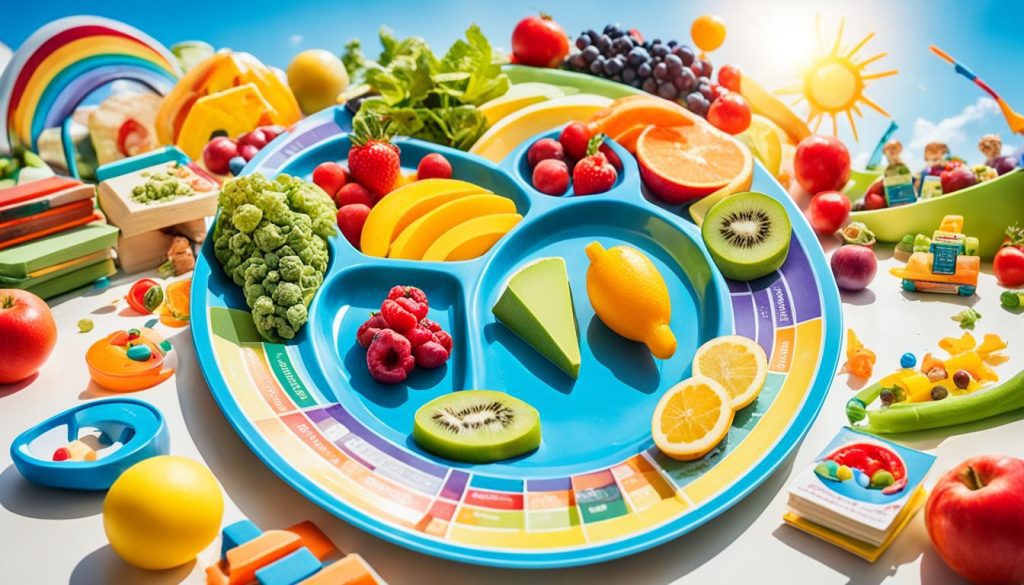When it comes to our children’s health and well-being, one of the most important factors to consider is their nutrition. Research has shown that good food choices are vital for the proper growth and development of children’s bodies and minds. As parents, we play a crucial role in guiding our children towards healthy eating habits and ensuring they receive the necessary nutrients for their overall health.
Child nutrition is a topic that cannot be overlooked, especially in today’s world where childhood obesity rates are on the rise. By encouraging a balanced diet for kids and instilling healthy eating habits from a young age, we can help prevent future health issues and empower our children to lead a vibrant and active life.
Creating nutrient-rich meals for kids doesn’t have to be complicated or expensive. In fact, there are simple yet effective strategies that we can implement in our daily lives to ensure our children receive the nutrition they need. From meal planning and packing healthy lunches to making informed choices while grocery shopping, every step we take matters in nourishing our children’s growing bodies.
Key Takeaways:
- Child nutrition is crucial for the growth and development of children’s bodies and minds.
- Encouraging a balanced diet and healthy eating habits from a young age can help prevent childhood obesity and promote long-term health.
- Simple strategies like meal planning, packing healthy lunches, and making mindful grocery choices contribute to providing nutrient-rich meals for kids.
- Parental guidance and involvement play a vital role in fostering healthy eating habits and supporting children’s overall well-being.
- By prioritizing our children’s nutrition, we empower them to thrive and lead a fulfilling life.
Making Healthier Food Choices for Kids
As parents, we have a significant role in teaching our children about healthy eating and guiding them towards making healthier food choices. By setting a good example and involving our kids in meal planning and cooking, we can instill lifelong habits that promote their well-being.
When it comes to meal planning, including children in the decision-making process can increase their interest and enthusiasm for nutritious meals. This can be as simple as asking them to choose a vegetable or fruit to include in the meal or letting them help with basic meal preparation tasks. Not only does this foster a sense of ownership, but it also encourages them to try new foods and flavors.
Eating meals at home provides an opportunity for us to have control over the ingredients and portion sizes. When we eat out, it can be challenging to make healthier choices due to the availability of processed foods and larger portion sizes. By prioritizing home-cooked meals, we can ensure that our kids are getting the nutrients they need while minimizing their consumption of unhealthy additives and excessive calories.
Additionally, packing healthy lunches and snacks for our children allows us to provide nourishing options even when they are away from home. It helps to avoid relying on convenience foods that are often high in sugar, sodium, and unhealthy fats. Investing a little time in planning and preparing nutritious meals and snacks can make a significant difference in their overall health.
| Benefits of Involving Children in Meal Planning and Cooking |
|---|
| 1. Increases their interest in nutritious foods |
| 2. Encourages them to try new foods and flavors |
| 3. Fosters a sense of ownership and responsibility |
| 4. Provides an opportunity for valuable learning experiences |
By focusing on making healthier food choices for our kids, we are setting them up for a lifetime of good health and well-being. In the next section, we will explore smart strategies for teenagers to make informed decisions about their nutrition and overall health.
Smart Choices for Teenagers’ Health
Teenagers have unique nutritional needs, and making smart choices is essential for their overall health and well-being. By focusing on personalized nutrition goals, staying hydrated with water, being physically active, making better beverage choices, and utilizing resources for healthy eating tips, teenagers can take control of their health and establish habits that will benefit them in the long run.
Personalized Nutrition Goals
Each teenager has different nutritional needs based on factors such as age, gender, and activity level. By setting personalized nutrition goals, teenagers can ensure that they are providing their bodies with the necessary nutrients. Consulting with a registered dietitian or using online tools and apps can help teenagers understand their individual nutritional needs and make informed choices.
Staying Hydrated with Water
Staying hydrated is crucial for teenagers’ overall health and cognitive function. Water should be the main source of hydration as it has no added sugars or calories. Flavoring water with fruits or vegetables can make it more appealing and encourage teenagers to drink more water throughout the day.
Being Physically Active
Regular physical activity is important for teenagers as it promotes cardiovascular health, builds strength, and supports healthy weight management. Encouraging activities such as morning stretches, walking, or engaging in online workouts can help teenagers incorporate physical activity into their daily routines.
Making Better Beverage Choices
Teenagers often consume sugary drinks and energy/sports drinks that are high in added sugars and calories. Encouraging them to make better beverage choices by opting for water, unsweetened iced tea, or low-fat milk can reduce their intake of empty calories and support healthy hydration.
Resources for Healthy Eating Tips
Several resources are available to help teenagers make healthier food choices. Websites, tip sheets, and mobile apps offer valuable information on nutritious recipes, meal planning, portion control, and more. Utilizing these resources can empower teenagers to make informed decisions about their dietary choices.
By focusing on personalized nutrition goals, staying hydrated with water, being physically active, making better beverage choices, and utilizing resources for healthy eating tips, teenagers can lay the foundation for a lifetime of good health. Empowering teenagers with the knowledge and skills to make smart choices not only benefits them now but also sets them up for a future of optimal well-being.
Tips for Encouraging Healthy Eating Habits in Preschoolers
Picky eaters can be a challenge when it comes to ensuring balanced nutrition for preschoolers. However, with some strategies and a little patience, you can encourage your child to develop healthy eating habits. Here are some tips to help you:
- Set a meal schedule: Establishing a consistent meal schedule with three meals and two snacks per day can provide structure and help regulate your child’s appetite. This can also prevent excessive snacking and ensure they have regular opportunities to consume essential nutrients.
- Increase physical activity: Encouraging your preschooler to engage in physical activity can stimulate their appetite and make them more receptive to eating nutritious meals. Plan active playtime, such as outdoor games or dancing, before mealtime.
- Introduce new foods: Preschoolers may need repeated exposure to new foods before accepting them. Be patient and offer new foods alongside familiar ones. Make it fun and exciting by describing the colors, textures, and tastes.
- Offer finger foods and table foods: Finger foods and table foods can make mealtime more enjoyable for preschoolers. Cut fruits and vegetables into bite-sized pieces, and provide food options that they can easily pick up and eat.
- Involve children in meal planning and preparation: Involving your preschooler in meal planning and preparation can increase their interest and investment in the food they eat. Let them choose ingredients, assist in simple tasks, and be part of the process.
- Minimize distractions during mealtimes: Create a calm and focused environment during mealtimes by minimizing distractions. Turn off the television, put away electronic devices, and encourage your child to concentrate on eating and enjoying their meal.
By implementing these tips, you can promote healthy eating habits in your preschooler and ensure they receive the needed nutrition for their growth and development.
| Benefits of Implementing Tips | Challenges to Overcome |
|---|---|
| Improved nutritional intake | Resistance to trying new foods |
| Development of healthy eating habits | Preference for unhealthy, processed foods |
| Increased appetite and enjoyment of meals | Negotiating for less nutritious options |
| Opportunities for family bonding | Time constraints and busy schedules |
Creative Strategies for Encouraging Healthy Food Choices in Children
When it comes to children, ensuring they have a well-rounded and nutritious diet is essential for their growth and well-being. However, getting them to eat healthily can sometimes be a challenge. That’s why we’ve compiled some creative strategies to encourage healthy food choices in children, making mealtimes fun and exciting.
Food Exploration for Children
Encouraging food exploration in children can help them develop a love for nutritious meals. Making it fun and sensory-oriented can enhance their eating experience. One way to do this is by cutting foods into fun shapes using cookie cutters or vegetable molds. Arranging food in the shape of a smiley face or their favorite animal can make mealtimes visually appealing and enjoyable.
Creative Food Presentation
Presentation is key when it comes to getting children excited about their meals. Creative food presentation can make even the simplest dishes more enticing. Try arranging fruits and vegetables in a rainbow pattern or creating funny faces using different ingredients. This not only makes the meal visually appealing but also introduces children to a variety of colors and flavors.
Adding Vegetables to Dishes
Getting children to eat their vegetables can be a daunting task. One way to incorporate more vegetables into their diet is by adding pureed vegetables to dishes they already enjoy. For example, mixing pureed spinach or carrots into pasta sauce or mac and cheese can boost the nutritional value without sacrificing taste. It’s a sneaky way to ensure they get the nutrients they need.
Setting a Good Example
Children learn by observing and imitating those around them, especially their parents. Setting a good example by eating a variety of healthy foods can go a long way in shaping their eating habits. Make an effort to enjoy a balanced diet yourself and let them see that eating nutritious meals is both delicious and beneficial.
Providing Nutritious Snacks
Snacks play a significant role in a child’s diet. Rather than offering unhealthy options, provide nutritious snacks that are both tasty and nourishing. Fresh fruits, yogurt, cheese sticks, and homemade granola bars are excellent choices. Having a variety of nutritious snacks readily available will make it easier for children to make healthier choices throughout the day.
Promoting a Lifetime of Healthy Eating
Instilling healthy eating habits in children from an early age sets the foundation for a lifetime of well-being. By incorporating these creative strategies into their daily routine, parents can promote a lifetime of healthy eating. Remember, small steps taken each day can make a significant impact on their overall health and future habits.
| Benefits of Creative Strategies for Healthy Food Choices | Examples |
|---|---|
| 1. Encourages food exploration | – Cutting foods into fun shapes – Arranging food in appealing patterns |
| 2. Makes meals visually appealing | – Creating funny faces with ingredients – Arranging fruits and vegetables in a rainbow pattern |
| 3. Sneaks in extra vegetables | – Adding pureed vegetables to sauces and dishes |
| 4. Sets a good example | – Eating a variety of healthy foods |
| 5. Provides nutritious snack options | – Fresh fruits – Yogurt – Cheese sticks – Homemade granola bars |
Importance of Nutrition in Early Childhood Education
Proper nutrition in early childhood sets the foundation for lifelong healthy eating habits. It is during these crucial years that children develop their taste preferences and learn to make food choices. By providing nutritious snacks in early childhood education settings, we can support children’s growth and development while promoting a positive relationship with food.
Early childhood education plays a significant role in shaping children’s eating habits. By offering a variety of nutritious snacks, such as fresh fruits, vegetables, and whole grains, we can expose children to different tastes and textures. This early exposure helps expand their palate and encourages them to make healthier food choices as they grow.
Furthermore, hot lunch programs in early childhood education settings can provide children with well-balanced and nutrient-rich meals. These programs often prioritize using fresh and quality ingredients to ensure that children receive the essential nutrients for their optimal growth and development.
Collaboration with pediatricians is another essential aspect of promoting early childhood nutrition. Pediatricians can offer valuable guidance in addressing any concerns related to children’s nutritional needs. They can provide expertise on portion sizes, food allergies, and dietary modifications, ensuring that children receive the necessary nutrients for their overall well-being.
Benefits of Early Childhood Nutrition:
- Establishes a foundation for lifelong healthy eating habits
- Promotes optimal growth and development
- Expands children’s taste preferences and food choices
- Supports a positive relationship with food
- Provides essential nutrients through hot lunch programs
- Allows collaboration with pediatricians for expert guidance
By prioritizing early childhood nutrition, we can lay the groundwork for a lifetime of healthy eating habits and positively impact children’s long-term health. Through nutritious snacks, hot lunch programs, and collaboration with pediatricians, we can ensure that children receive the nourishment they need to thrive.
Conclusion
Parents play a crucial role in fostering healthy eating habits and supporting the growth and development of their children. By making smart food choices, involving children in meal planning and preparation, and setting a good example, parents can promote a balanced diet and encourage healthy eating habits.
Child nutrition is essential for growth and development, and a balanced diet is key to providing the necessary nutrients. This includes incorporating a variety of fruits, vegetables, whole grains, lean proteins, and dairy products into children’s meals. By offering a wide range of nutritious options, parents can ensure that their children receive the nutrients they need for optimal health.
Additionally, parental support is crucial in establishing healthy eating habits. Through positive reinforcement and encouragement, parents can help children develop a lifelong appreciation for nutritious foods. Regular family meals create a bonding experience and provide an opportunity to model healthy eating habits.
Remember, dietary preferences may change as children grow, and it is important to be flexible. By taking small steps each day, such as introducing new foods and finding creative ways to make healthy eating enjoyable, parents can pave the way for a lifetime of healthy habits and contribute to their children’s overall well-being.
FAQ
Why is good nutrition important for children?
Good nutrition is important for children because it supports their growing bodies and minds. It helps them develop properly and perform well academically and physically.
How can parents be good role models for healthy eating?
Parents can be good role models by eating healthy themselves and being physically active with their children. Children are more likely to adopt healthy habits when they see their parents practicing them.
What is the GO, SLOW, WHOA approach to food?
The GO, SLOW, WHOA approach categorizes foods into three groups based on their nutritional value and impact on health. GO foods are the healthiest, SLOW foods are to be eaten in moderation, and WHOA foods should be consumed sparingly.
Does healthier eating have to be more expensive?
No, healthier diets don’t have to cost more. Cooking at home can be affordable and allows you to control the ingredients and portion sizes. Planning meals and shopping smart can help save money while eating nutritiously.
How can I pack healthy lunches and snacks for my child?
You can pack healthy lunches and snacks by including a variety of fruits, vegetables, whole grains, and lean proteins. Avoid sugary and processed foods. Get creative with food presentation to make it appealing.
How can teenagers make smart food choices?
Teenagers can make smart food choices by focusing on their personalized nutrition goals. They should stay hydrated with water, engage in physical activities, make better beverage choices, and access available resources for healthy eating tips.
What can I do to encourage healthy eating habits in my picky-eating preschooler?
To encourage healthy eating habits in your picky-eating preschooler, set a meal schedule, increase physical activity to stimulate hunger, offer a variety of foods frequently, involve your child in meal planning and preparation, and minimize distractions during mealtimes.
How can I make mealtimes more enjoyable for my child?
You can make mealtimes more enjoyable for your child by making food fun and sensory-oriented. Cut foods into fun shapes, use food in games, and offer finger foods. Add pureed vegetables to dishes to increase nutrient intake.
Why is nutrition important in early childhood education?
Nutrition in early childhood education is important because it sets the foundation for lifelong healthy eating habits. Providing nutritious snacks in childcare and hot lunch programs can support children’s growth and development.
How can parents support their child’s growth and development through nutrition?
Parents can support their child’s growth and development through nutrition by making smart food choices, involving children in meal planning and preparation, and setting a good example. Small steps taken each day can contribute to a lifetime of healthy eating.



